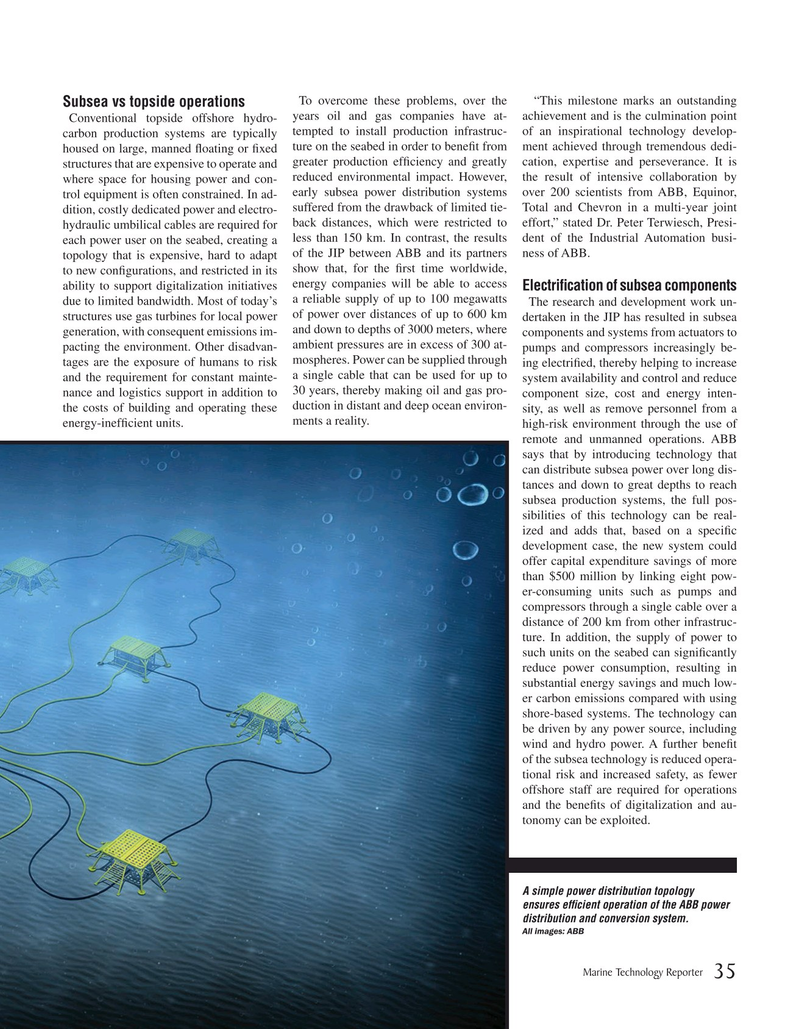
Page 35: of Marine Technology Magazine (April 2020)
Read this page in Pdf, Flash or Html5 edition of April 2020 Marine Technology Magazine
To overcome these problems, over the “This milestone marks an outstanding
Subsea vs topside operations years oil and gas companies have at- achievement and is the culmination point
Conventional topside offshore hydro- carbon production systems are typically tempted to install production infrastruc- of an inspirational technology develop- housed on large, manned foating or fxed ture on the seabed in order to beneft from ment achieved through tremendous dedi- greater production effciency and greatly cation, expertise and perseverance. It is structures that are expensive to operate and reduced environmental impact. However, the result of intensive collaboration by where space for housing power and con- early subsea power distribution systems over 200 scientists from ABB, Equinor, trol equipment is often constrained. In ad- suffered from the drawback of limited tie- Total and Chevron in a multi-year joint dition, costly dedicated power and electro- hydraulic umbilical cables are required for back distances, which were restricted to effort,” stated Dr. Peter Terwiesch, Presi- each power user on the seabed, creating a less than 150 km. In contrast, the results dent of the Industrial Automation busi- topology that is expensive, hard to adapt of the JIP between ABB and its partners ness of ABB.
to new confgurations, and restricted in its show that, for the frst time worldwide, ability to support digitalization initiatives energy companies will be able to access
Electrifcation of subsea components due to limited bandwidth. Most of today’s a reliable supply of up to 100 megawatts
The research and development work un- structures use gas turbines for local power of power over distances of up to 600 km dertaken in the JIP has resulted in subsea generation, with consequent emissions im- and down to depths of 3000 meters, where components and systems from actuators to ambient pressures are in excess of 300 at- pacting the environment. Other disadvan- pumps and compressors increasingly be- tages are the exposure of humans to risk mospheres. Power can be supplied through ing electrifed, thereby helping to increase and the requirement for constant mainte- a single cable that can be used for up to system availability and control and reduce nance and logistics support in addition to 30 years, thereby making oil and gas pro- component size, cost and energy inten- the costs of building and operating these duction in distant and deep ocean environ- sity, as well as remove personnel from a ments a reality.
energy-ineffcient units. high-risk environment through the use of remote and unmanned operations. ABB says that by introducing technology that can distribute subsea power over long dis- tances and down to great depths to reach subsea production systems, the full pos- sibilities of this technology can be real- ized and adds that, based on a specifc development case, the new system could offer capital expenditure savings of more than $500 million by linking eight pow- er-consuming units such as pumps and compressors through a single cable over a distance of 200 km from other infrastruc- ture. In addition, the supply of power to such units on the seabed can signifcantly reduce power consumption, resulting in substantial energy savings and much low- er carbon emissions compared with using shore-based systems. The technology can be driven by any power source, including wind and hydro power. A further beneft of the subsea technology is reduced opera- tional risk and increased safety, as fewer offshore staff are required for operations and the benefts of digitalization and au- tonomy can be exploited.
A simple power distribution topology ensures effcient operation of the ABB power distribution and conversion system.
All images: ABB www.marinetechnologynews.com
Marine Technology Reporter 35

 34
34

 36
36
